My first Bike-to-Work Week in Cedar Rapids since 2019--I was in Belgrade last year--comes with much anticipation, though mingled with concern. The incredible weather forecast and four years of deprivation have me utterly psyched for this. However, this year's schedule is visibly thinner, missing some of the highlights of earlier years, and oriented more to trail riding than commuting. (More on the importance of this distinction later.)
The disorientation started early. The traditional mayor's proclamation was moved from Monday morning downtown to the previous Thursday evening at New Bo City Market, and was delivered in the absence of the actual mayor by City Council member Ann Poe.
 |
| Ms. Poe read it like a pro, having done it once before in 2016 |
The proclamation was attended by maybe three citizen cyclists, along with city staff promoting various initiatives...
 |
city displays included posters for Connect CR
and a planned intergenerational center |
...and some rather puzzled citizens who were there for weekly Jazzercise. Later came the regular weekly bike ride connected to Meet Me at the Market, which I was not able to attend. (I also had to miss Saturday's MPO Ride.)
I had shown up to the proclamation 45 minutes early--did I mention I was psyched?--in a bright neon Bike to Work Week t-shirt. The young city staff setting up their displays had not seen this artifact. "From back when there was money," one said. Oh boy.
 |
| May 2019: Post-proclamation breakfast at Jimmy Z's |
Monday, May 15
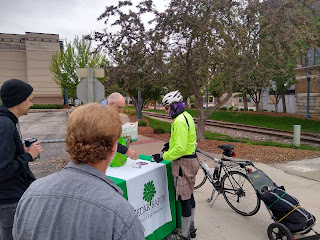 |
Cedar Valley Nature Trail pit stop at 2nd Avenue SE,
about 8:30 a.m. |
Bike to Work Week started chilly and gray this morning, though the forecast for the week remains ideal. Pit stops around town return as a key feature of the week. I got to the downtown location about halfway through the 6:45-8:45 morning shift and, frankly, did not see much action. The guys at the pit stop, Steve Hershner from the city and a young man from Hall Bicycle whose name I didn't catch, reported more people coming through during the half hour before I got there, and a fair-sized group of trail riders at about 7. Steve was resplendent in his BTWT shirt from 2019, the one with the bike map of Cedar Rapids that long-time readers will remember I didn't get, albeit in the chill he had several layers over it.
 |
| snacks available at the morning pit stop |
This afternoon, I visited the pit stop at Collins Aerospace. Getting there from Coe College was a little tricky through the after-school/rush hour traffic, but I made it. (I prefer side streets to main streets, even if there are bike lanes, so I forsook the chance to try out some of the newer bike infrastructure.)
By this time, the sun was out and the air was considerably warmer than the morning had been. We saw quite a bit of traffic on the Lindale Trail that runs along the north edge of the Collins campus. Derek Stepanek from Northtowne Cycling and Fitness was helping people test ride e-bikes. He was kept busy the whole time I was there.
Betsy was there from the City, and it turns out she's also in charge of coordinating the bikeshare program, which gave me the opportunity to mention there's been a scooter in front of my house...
...since Friday night, and another one two doors down, which I can't report through the app because it won't allow me to upload the picture it insists on having. She suggested I try the phone number, and pointed out other people are reporting wayward scooters without this problem.
I have problems other people don't have? Story of my life...
Tuesday, May 16
Today's Bike to Work Week event was the Bike to Lunch Business Challenge, initiated in 2019, and this year timed to coincide with the New Bo City Market's weekly Food Truck Tuesday. I enjoyed West African peanut and sweet potato stew, the weekly special from The Full Bowl.
 |
| (Note: this is not a truck) |
Roman Kiefer from the Corridor MPO and Haley Sevening from the City were on hand to answer people's questions about trails...
...particularly the planned completion of the Lindale Trail (in 2024) and the
CeMar Trail (in 2025), which when completed will not only be useful for commuters but for recreational riders will create a huge loop between downtown Cedar Rapids and Uptown Marion.
Visitors left a fair number of wishes as well, mostly related to trail riding.

Not everyone in the considerable turnout was there for Bike to Work Week, but the level of interest in cycling, particularly trails, was encouraging.
This morning I joined a
webinar this morning on safe streets hosted by Gilbert Penalosa's organization,
880 Cities, featuring guests from Hoboken and Seattle. Ryan Sharp, director of transportation and parking for Hoboken (pop 60,000), which has had no traffic deaths in 6+ years, credited "a lot of good fortune" but also 13 years of deliberate preventive actions like protected bike lanes, curb extensions, "daylighting" parking areas, road diets, pedestrian islands to reduce pedestrian crossing distances and vehicle speeds. Allison Schwartz and Brad Topol from the Seattle (pop 730,000) dept of transportation noted that despite that city's increase in pedestrian and cycle deaths since 2019, where there have been separation and slowing vehicles those have gone down.

The Seattle presenters stressed shifting away from consideration of isolated individual blame to system accountability. (On the contribution of design factors see also
Sheppard 2023). The core goal is to go beyond reducing tragedies, and to design a system where everyone feels safe moving around the community--regardless of transportation mode, race, sex, and income level.
Getting there requires more than trails, and more than bike lanes. This morning I drove--heretic!!--from my house to the YMCA, which is a little more than a mile, and spotted three cyclists (all white men). What would it take to get three to, say, thirty? with more diversity to boot? Is the city mentally prepared for this to happen? Can we help it happen? Do we even want it to happen? (The last is meant ironically, of course. I may be a backslider but I'm no heretic!)
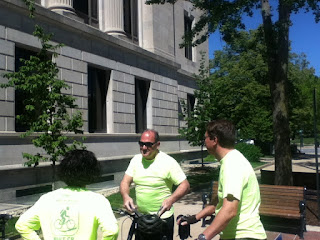 |
| May 2016: Bike to Lunch with the mayor at Kickstand |
Wednesday, May 17
The Ride of Silence is where Bike to Work Week shows its serious side, commemorating those who have been killed in road crashes, typically from being hit by motor vehicles. Roman Kiefer of the Corridor MPO (pictured above) began the ride by citing recent statistics from the area: no one killed so far this year, one serious injury, with four last year in 267 collisions. It shows the frustrating limitation of infrastructure; even with a network of connected trails and protected lanes, sooner or later one has to cross paths with motor vehicles, and as those get bigger and faster (see
Benfield 2023) tragedies will happen unless something can be done to address that.
Car-dependence is also bad for nature and public health. Last night's
The War on Cars podcast featured an interview with Amy Westerveldt, host of the podcast
Drilled. She is
currently reporting on environmental damage and political corruption caused by Exxon's oil extraction in the South American nation of Guyana. This week
ProPublica has a story on the aftermath of oil extraction in California, which has left a bill so large that neither industry nor government can cover it (
Olade 2023). Our thirst for oil has all sorts of harms, which makes the promotion of bicycle commuting all the more vital.
The ride began and ended at City Square in Marion, wending 5.6 miles through the streets of Marion and far northeast Cedar Rapids. We had a Marion police car before...
...and a Cedar Rapids police car behind. We rode Marion Boulevard to Blairs Ferry Road to C Avenue to Boyson Road, then back on Central Street. Those are some serious stroads. I don't recommend doing any of that without a police escort!
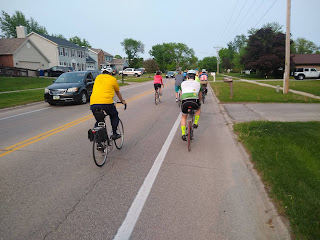 |
| Riding east on Boyson Road in Cedar Rapids |
The ride really did happen in silence. Most other people we encountered were respectful, and we got some cheers from people sitting outdoors at Villa's Patio. Coming back in on 10th Street, I heard a little girl ask her father, "What is that? It looks like a parade." I thought particularly of Dan Lehn, my Coe College colleague who was hit by a truck in July 2016. Dan loved people--his family, his friends, his students, and everyone else, too. How tragic to have such a sweet spirit taken from us too soon.
Scenes from earlier today:
 |
| Morning pit stop downtown |
 |
Afternoon bike ride: Transamerica campus
|
Also today, the Veo scooter disappeared from in front of our house, after four-plus days. It happened without our intervention, as I never did get the app to work.
Thursday, May 18
 |
| Bad news for someone in Czech Village this morning |
This morning I rode across the
Bridge of Lions into Czech Village to meet a friend for coffee. I found this sad remnant pictured above as I locked my own bike. If nothing else, the theft shows infrastructure is far from being the only or even the primary existing obstacle to confident bicycle commuting on a mass scale.
Another issue is the size and speed of vehicle traffic, which is unusually high on 16th Avenue these days because of the major construction project on the 12th Avenue bridge. As motor vehicles get bigger, streets are more crowded and cyclists, pedestrians, wheelchair users, and others are less confident of even being seen.
Today's Bike to Work Week events included a pit stop at New Bo City Market, sponsored by Goldfinch Cyclery.
I chatted with Lillian from Goldfinch, who in addition to bicycle expertise has a passion for social justice, but is unsure how bicycling can help. It seems cycling can speak to economic and racial equity--and the viability of small local businesses--as well as environmental sustainability, but it doesn't happen automatically. It will take intentional effort, along a path that is murky at best.
Lillian also suggested a fix for my floppy handlebar grip, which involved walking my bike over to the shop and getting a new cap put on the end.
 |
| Good as new! Thanks, Goldfinch!! |
At 6:00 the weekly Meet Me at the Market ride departed. Eight of us took the Cedar River Trail south to Hoover Park and back, about 15 miles in all.
The suburban subdivisions sprouting on the southwest side have rather nice trail access to the core.
After the ride, there was a small Corridor Urbanism meetup at Kickstand in New Bohemia.
The beer and conversation were good, but I was stunned by the number of bikes at the bar on a Thursday evening.

Maybe we should change it to Bike to the Bar Week!
What we've been missing, by failing to keep the focus of the week on bicycle commuting, are the sorts of events held in earlier years that were specifically focused on commuting, such as how to encourage more of it...
 |
May 2017: Nikki Northrop Davidson, Bike2Work Consultants
presents "Bike to Work 101" at the Metro Economic Alliance |
...and bike-friendly workplaces (featuring the building where I am now writing!).
.JPG) |
May 2014: Geonetric's bike-friendly building under construction
(destination of group ride with the mayor)
|
Maybe these aren't exactly the ticket, though as an academic I'm always up for a panel, particularly if there's coffee! And with all the construction going on in the core, and elsewhere in the city, it would be nice to feature what architects and employers are doing.
It is good to celebrate the increase in the size and connectivity of our metro's trails networks, but trails won't save the world. Bike commuting could save the world, if we wanted it to.
Friday, May 19
Bike to Work Week culminated, as always, in an after-party, tonight at Sag Wagon, a bike-themed bar overlooking Cedar Lake.
Ron Griffith pointed out the Sag Wagon has a trail map painted on one outside wall.
We gathered at 5, mingled among the other bar patrons; I sat with fellow BTWT enthusiasts Chase and Desiree. At 6 they started handing out prizes. Based on the number of cross-outs on my Bike to Work Week bingo card...
...I had first crack at the prize table, and I scored a water bottle from Goldfinch and a t-shirt from Hall Bicycle. Other than the fact that the t-shirt appears to say "Smack me," which I certainly don't want to encourage, this was arguably my best Bike to Work Week ever from a materialistic standpoint.
 |
| (photo by Haley Sevening) |
Bike to Work Week 2023 was a lot of fun, but also missed opportunities. This will take another blog post to work out, however, as it is high time I closed this one.
See also:
"Trails and Bikeways Ideas," 19 February 2023
"Bike to Work Week Diary 2019," 13 May 2019 [includes links to earlier posts]
Kaid Benfield, "CARZILLA: Are Huge SUVs and Trucks Hurting Pedestrians and Walkable Communities," PlaceMakers, 5 May 2023
Alec Davis, "Can You Live a Car-Free Life in Des Moines?" Waste of Space, 6 May 2023 [includes ref to bike neighborhoods]
Bill Pugh, "Bike Bike Baby: How Greater Washington Can Boost the E-Bike Revolution," Greater Greater Washington, 10 May 2023
David Zipper, "Bikeshare's Proud Past and Shaky Future," Paved with Good Intentions, 8 May 2023












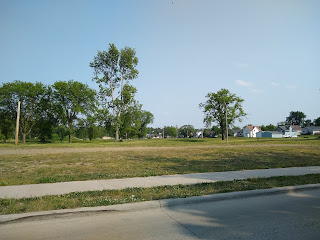













.JPG)







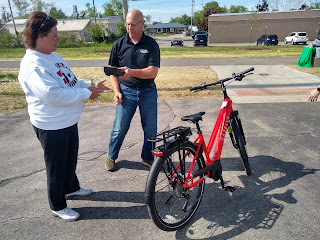



















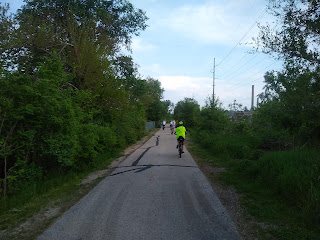



.JPG)







